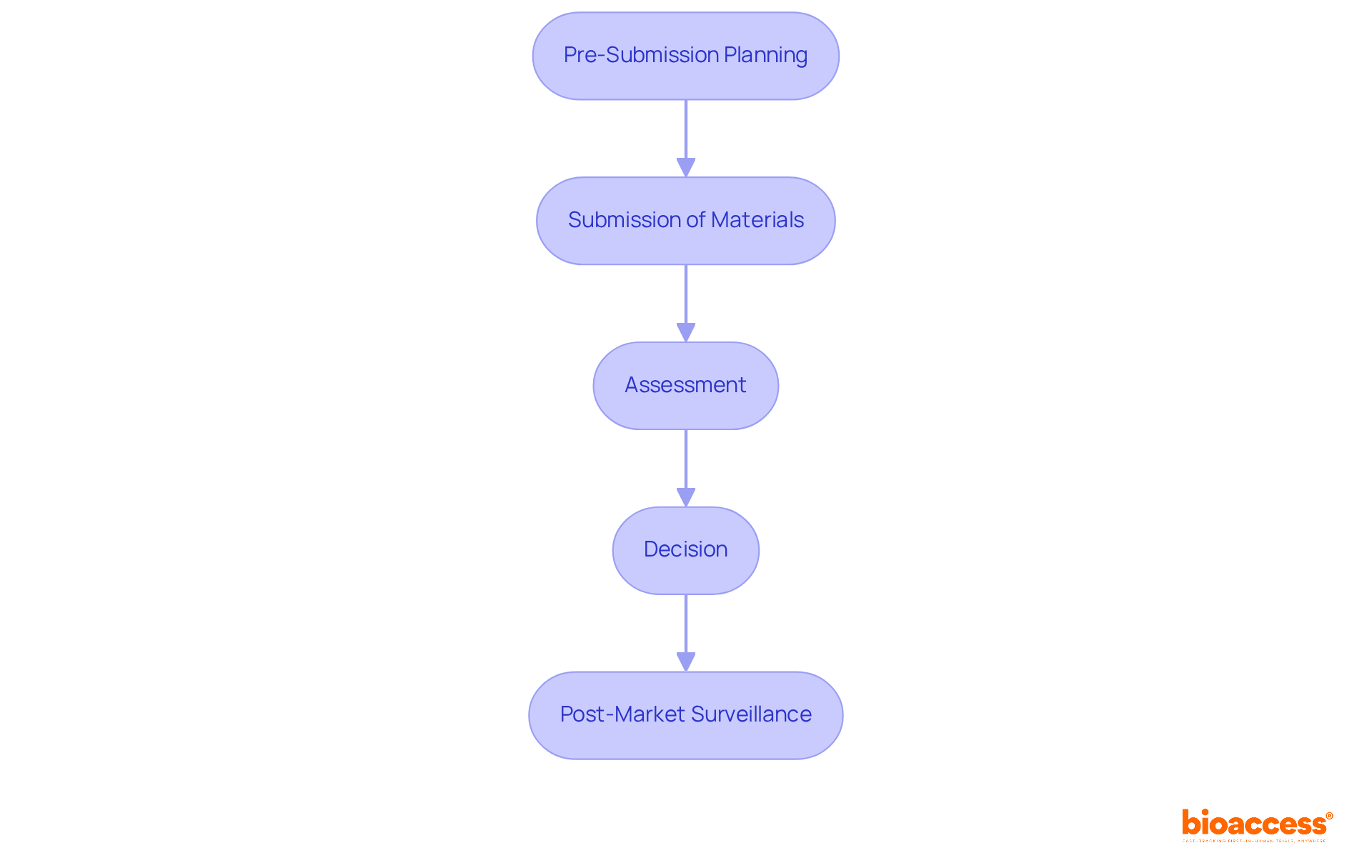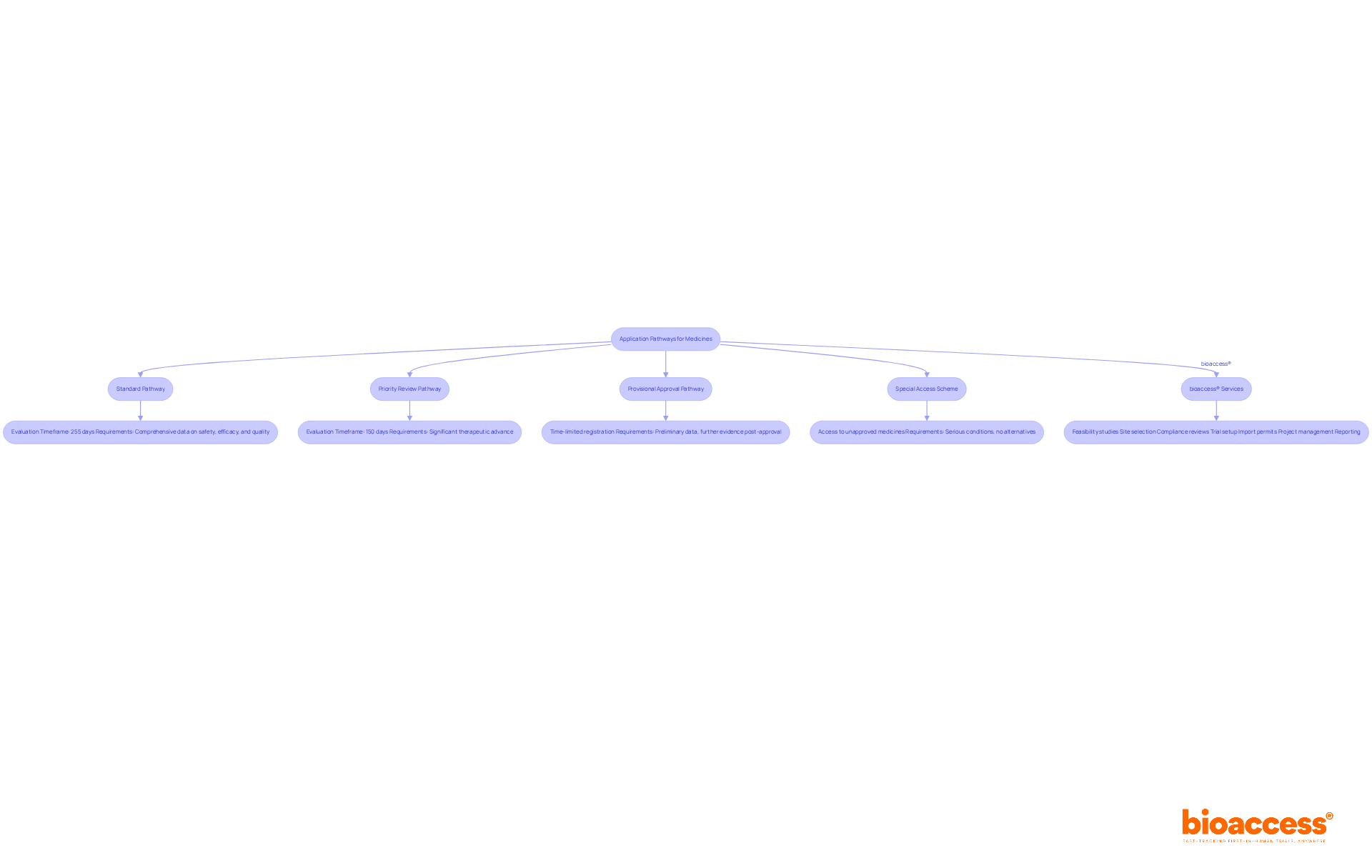


This article delineates the steps and considerations essential for navigating the Australian Therapeutic Goods Administration (TGA) approval process for therapeutic products. It articulates crucial phases including:
Understanding TGA guidelines is paramount, as it ensures compliance and facilitates successful product approval. The significance of these processes cannot be overstated, as they play a critical role in the Medtech landscape, addressing key challenges faced by clinical researchers.
Navigating the approval process for therapeutic goods in Australia presents significant challenges, particularly due to the stringent regulations enforced by the Therapeutic Goods Administration (TGA). This guide serves as a comprehensive roadmap, elucidating the TGA's role and outlining the necessary steps to secure approval for new medicines and medical devices.
With various application pathways and fast-tracked options at one's disposal, the critical question arises: how can a submission not only meet regulatory requirements but also distinguish itself in a competitive landscape?
The Australian Therapeutic Goods Administration (TGA) serves as Australia's regulatory authority, dedicated to ensuring the safety, quality, and effectiveness of therapeutic products, which encompass drugs and medical devices. Understanding the Australian Therapeutic Goods Administration's pivotal role is essential for effectively navigating the authorization process.
The TGA meticulously evaluates applications for new medicines and medical devices, confirming that they adhere to stringent regulatory standards prior to being marketed in Australia. This evaluation encompasses a thorough assessment of:
All aimed at ensuring ongoing safety and compliance. Familiarizing yourself with the Australian Therapeutic Goods Administration's guidelines and requirements is the critical first step in successfully securing consent for your therapeutic goods.

The approval process for therapeutic goods encompasses several essential steps:
Pre-Submission Planning: Prior to submitting a proposal, it is crucial to conduct comprehensive research to understand the TGA's requirements and compile necessary documentation, including clinical trial data and manufacturing details.
Submission of Materials: Submit your documents via the TGA's online portal. It is imperative to ensure that all required documents are included to prevent any delays in processing.
Assessment: The Australian Therapeutic Goods Administration (TGA) will evaluate your submission, which may entail multiple rounds of inquiries and clarifications. Be prepared to respond quickly to any requests for additional information.
Decision: Following the evaluation, the TGA will render a decision. If approved, your product will be listed on the Australian Therapeutic Goods Administration's Australian Register of Therapeutic Goods (ARTG).
Post-Market Surveillance: After your product reaches the market, it is essential to continue monitoring its safety and efficacy, reporting any adverse events to the TGA as mandated.

The TGA offers several application pathways for medicines, each designed to cater to different needs:
Standard Pathway: This is the most common route for new treatments, requiring comprehensive data on safety, efficacy, and quality. The evaluation timeframe is typically 255 working days.
Priority Review Pathway: For treatments that represent a significant therapeutic advance, this pathway allows for expedited evaluation, usually within 150 working days. To qualify, the treatment must meet specific criteria demonstrating its potential advantages.
Provisional Approval Pathway: This pathway is intended for promising treatments that address unmet medical needs. It allows for a time-limited registration based on preliminary data, with the requirement to provide further evidence post-approval.
Special Access Scheme: This scheme allows access to unapproved medicines for patients with serious conditions when no alternative treatments are available. Applications can be made by healthcare professionals on behalf of patients.
In navigating these pathways, bioaccess® provides comprehensive clinical trial management services, including feasibility studies, site selection, compliance reviews, trial setup, import permits, project management, and reporting. With regulatory sanction timelines significantly shortened to 6-8 weeks compared to the usual 6-12 months in the US/EU, bioaccess® quickens the permission processes for startups, enabling faster patient enrollment in treatment-naive cardiology or neurology groups, achieving this 50% quicker than Western sites, as per the guidelines of the Australian Therapeutic Goods Administration. This efficiency is crucial for overcoming regulatory challenges in early-phase clinical trials.

For urgent treatments, the TGA provides several fast-tracked approval options:
Priority Review Pathway: This pathway accelerates the assessment process for therapies that offer significant advantages over existing treatments. It is crucial that your submission clearly outlines these advantages to facilitate a swift review.
Provisional Approval Pathway: This option enables quicker access to promising therapies based on preliminary data. It is especially beneficial for treatments targeting serious conditions where alternatives are lacking.
Special Access Scheme: This scheme allows for the provision of unapproved medicines to patients in critical need. A healthcare expert must present the request, emphasizing the urgency and importance of the treatment to ensure its approval.
Collaboration with TGA: Engaging with the TGA early in the development process is essential. Discussing potential fast-tracking options with them can help streamline your application and ensure compliance with regulatory expectations.

Navigating the Australian Therapeutic Goods Administration (TGA) approval process is a vital undertaking for anyone involved in the development of therapeutic goods. Understanding the TGA's role as the regulatory authority is essential to ensure that products are safe, effective, and meet the required standards before reaching the market. This process transcends a mere bureaucratic hurdle; it is a fundamental step in safeguarding public health and maintaining the integrity of therapeutic products in Australia.
This article outlines a clear roadmap for successfully maneuvering through the TGA approval process. Key stages include:
Each step is meticulously designed to facilitate compliance and streamline the approval timeline, allowing for faster access to innovative treatments, especially for urgent medical needs.
In conclusion, the significance of the TGA in regulating therapeutic goods cannot be overstated. Engaging with the TGA early in the development process, understanding the various approval pathways, and utilizing fast-tracked options when necessary can greatly enhance the chances of a successful application. For stakeholders in the healthcare industry, staying informed about the TGA’s processes and requirements is crucial for ensuring that life-saving therapies can reach patients in a timely manner. Embracing this knowledge not only supports compliance but ultimately contributes to the advancement of healthcare in Australia.
What is the role of the Therapeutic Goods Administration (TGA) in Australia?
The TGA is Australia's regulatory authority responsible for ensuring the safety, quality, and effectiveness of therapeutic products, including drugs and medical devices.
What types of products does the TGA regulate?
The TGA regulates therapeutic products, which encompass both drugs and medical devices.
What is the process the TGA follows for new medicines and medical devices?
The TGA evaluates applications for new medicines and medical devices to ensure they meet stringent regulatory standards before being marketed in Australia.
What aspects does the TGA assess during its evaluation process?
The TGA assesses clinical trial data, manufacturing processes, and post-market surveillance to ensure ongoing safety and compliance.
Why is it important to understand the TGA's guidelines and requirements?
Familiarizing yourself with the TGA's guidelines and requirements is essential for successfully securing consent for therapeutic goods.